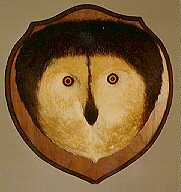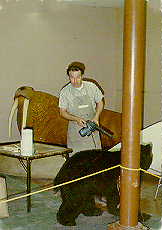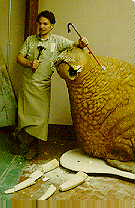
|
We asked Mark Minton, founder and owner of Trophy Care International, to tell us just
where he's been and what all he has done to equip himself for this unique, fascinating business.
Here, with personal photos and in his own words, is his story. I started in taxidermy in 1958 by sort of borrowing my older brothers lesson books from Northwest School of Taxidermy, a correspondence school out of Omaha, Nebraska. Hired by Jonas Bros. of Seattle in 1960, I started out skinning and fleshing, 8 hours a day, with 2 other guys. After hunting season the others moved to the Taxidermy department while I stayed behind skinning, boiling skulls, making forms and bases and doing whatever was needed.
Spring of 1961 found me working for Jonas Brothers as an apprentice under a talented
Hungarian taxidermist we simply called John "K" because none of us could pronounce his last
name! I've known John Kerszturi over 35 years now and I'm still not sure of his last name!  South end of a north-bound Stone sheep, a "Hootenanny."Next, "Rug Stretching." We learned the old fashioned way before air staple guns! First we soaked a head-mounted skin in water and nailed the wet skin out flat on a board large enough to hold it. Nails were placed as close together as possible and if it was a Polar Bear, believe me, it took a huge board and a tremendous amount of nails! Thoroughly dried out, nails removed, the evenly trimmed skin was sent on to the ladies who lined the rugs. In the Shipping Department for about 6 months, I became quite interested in the boss's daughter and... uh... the Finishing Department, which she managed. I transferred to that department, learned to "put the life" back into the mounts, lost the girl, and found my niche! Taking over as manager, I spent over 8 years in that department. I've put finishing touches on Humming Birds, half life size Elephants, and almost anything you could name in between, since then! My first museum work, while in finishing, was at Seattle's Museum of History and Industry in 1963. 1 helped set up some of the wildlife dioramas. Shortly after starting "Finishing" I began doing all the cleaning, repair, and restoration work on old mounts which were shipped, or brought, in to the studio. Often there were so many I would take some home on weekends, just to keep up with all of the work. Leaving Jonas Brothers for the first time, in 1964, I continued doing cleaning and repairs on my own, on a limited basis. Away for 2 years, I married my first wife (been married to her 32 years now) and we spent 7 months in her native country, Norway. Fall of 1966 and it was back to Jonas Brothers again (now with "Klineburger" attached to the name) managing up to 5 people in "Finishing" and again doing all their clean and repair work. In the summer of 1970, I went alone on my first "on location" clean & repair job. Klineburger's "Jonas Bros. of Alaska Museum" in Anchorage was being sold and all mounts damaged in the March 27, 1964 Alaska earthquake had to be put back in shape. I was approached, while there, by Klineburgers Agent to help in the Receiving Station for the coming fall season. My wife and I had another trip to Norway planned, but I agreed to come on up and do it!
World Record Walrus tusks, badly broken in the earthquake, had to be replaced with artifical ones, cast from the originals.
In Norway for almost a year, I worked for A/S Biologiske Preparater, called A/S Bio-Prep, one of the largest taxidermy firms in Europe. I did mounting, worked as advisor on museum projects, and I instructed the owner and his employees in American methods of taxidermy, in particular, more advanced finishing techniques. I also did some cleaning and repair work on the side. Fall of 1971, and it was back to Anchorage for the hunting season, this time with my wife and kids. After that it was back to the main studio in Seattle. In the early 1970's, Klineburgers acquired a Wax Museum business, sculpting life-sized human figures out of wax. I worked in that department about 6 months. Though it was short-lived, that work was a real challenge! It very definitely helped me in the sculpting work I'm called on to do on various restoration projects for Trophy Care International. Spring of 1975 I left Klineburgers, again, to start NW Mannequin where we repaired and refinished store window dummies for all the major department stores. For the next 13 years, working various jobs, I still kept my hand in taxidermy cleaning and repair work though on a part-time basis only. 1988. Klineburgers called me back to work as Customer Service Rep and Shop Manager, overseeing more than a dozen employees. This time my responsibilities included doing trophy Appraisals for some of our clients. In 1989, and again in 1992, after Desert Storm, I was sent to Saudi Arabia to work on mounts for a very prominent member of the Saudi Arabian Royal Family. The last time my 14 year old son, Dan, went with me! We thoroughly enjoyed Saudi Arabia. After that last trip, Klineburger Taxidermy downsized and my position was eliminated. We immediate launched our present company, Trophy Care International. Trophy Care International, now incorporated, was contracted in 1994 to clean and repair as needed, all of over 400 mounts in the International Wildlife Museum, at Safari Club International's Headquarters in Tucson, AZ. We cleaned nearly all the mounts again in 1996 and have been back for a number of restoration projects through the years since 1994. So we continue, anywhere in the world we are needed.
Phone/Fax: 360-653-7300 or Cell Phone: 206-353-8813
or contact us through our

|

